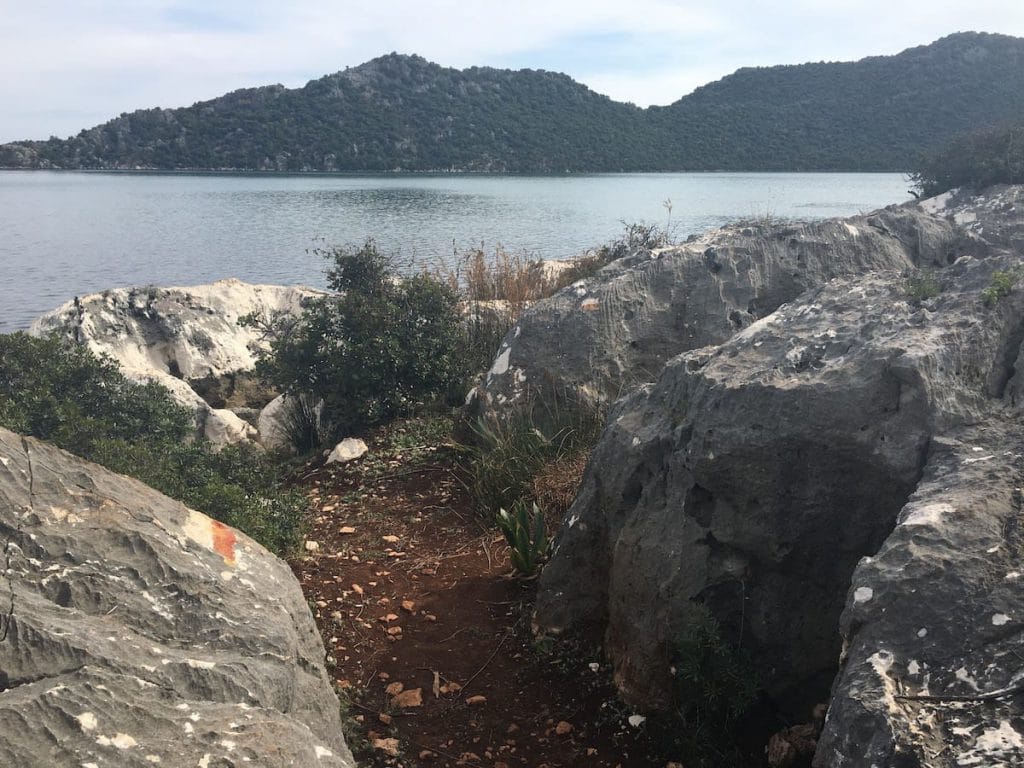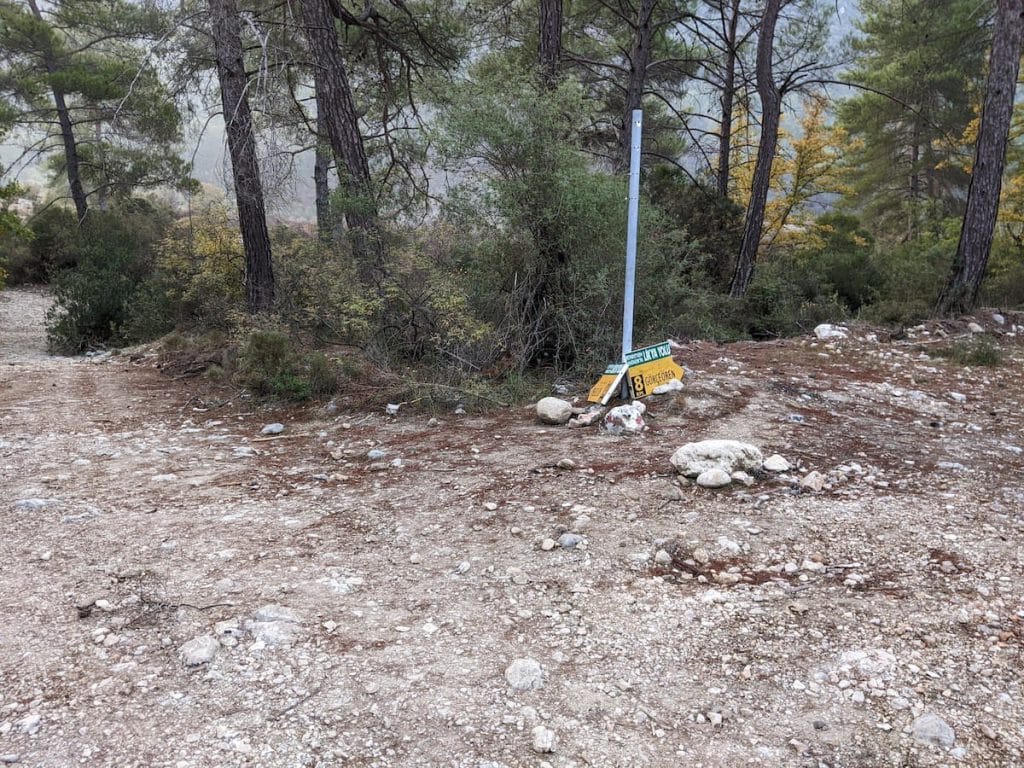
The Right Mindset
For way-finding purposes, having the right mindset is critically important on the Lycian Way. If you go to the Lycian Way expecting the kind of trail markings you’d find on a typical long-distance trail in France, Germany, the UK, or the United States you’re going to end up frustrated and lost. It’s that simple.
On the other hand, if you pay extra-close attention to your surroundings, have some good-quality GPS tracks with you, and come prepared with an appropriate ‘can-do’ attitude, then, um, you’ll still end up lost.
But not as frustrated!
That’s right: You will get lost.
Seriously. You will. More than once. Just accept it.
There. With that out of the way, we can also say that you will find your way, too. You’ll get from point A to point B on the Lycian Way and probably have a damned good time doing it even if you unintentionally visited points C and D along the way.
It isn’t so much that the way-markings are bad –they’re actually pretty good, overall– it’s just a combination of factors ranging from constant construction in the region to too-frequent tweaking of the route to sometimes-poor trail maintenance to the nature of the terrain itself to a dozen other factors.
You won’t have to worry about navigation, it’s not quite that bad, but going into it knowing that there will be some confusing junctions, that you will sometimes have to backtrack, that you’ll have to find a way around unexpected obstacles (“Who put that new house smack-dab in the centre of the trail?”), and so on, makes it much less frustrating and more of an adventure when it does happen.
Most of the time you won’t have any problems at all. But sometimes you will. No worries. Life is like that sometimes.
On the other hand, if you pay extra-close attention to your surroundings, have some good-quality GPS tracks with you, and come prepared with an appropriate ‘can-do’ attitude, then, um, you’ll still end up lost.
But not as frustrated!
That’s right: You will get lost.
Seriously. You will. More than once. Just accept it.
There. With that out of the way, we can also say that you will find your way, too. You’ll get from point A to point B on the Lycian Way and probably have a damned good time doing it even if you unintentionally visited points C and D along the way.
It isn’t so much that the way-markings are bad –they’re actually pretty good, overall– it’s just a combination of factors ranging from constant construction in the region to too-frequent tweaking of the route to sometimes-poor trail maintenance to the nature of the terrain itself to a dozen other factors.
You won’t have to worry about navigation, it’s not quite that bad, but going into it knowing that there will be some confusing junctions, that you will sometimes have to backtrack, that you’ll have to find a way around unexpected obstacles (“Who put that new house smack-dab in the centre of the trail?”), and so on, makes it much less frustrating and more of an adventure when it does happen.
Most of the time you won’t have any problems at all. But sometimes you will. No worries. Life is like that sometimes.
Trail Markings

Red and white blaze on a boulder. Photo by Rebecca Scheer, fall 2022.
The Lycian Way uses a system of red and white blazes to mark the trail. Blazes are painted on trees or boulders and sometimes on the trail itself.
In some areas the blazes are frequent – you’ll be able to see the next blaze from the current one, which is the ideal that every trail’s maintenance team strives for. Often, though, blazes are only found at major trail junctions, which can sometimes lead to confusion at minor junctions between blazes.
Sometimes, especially at major trail junctions, you will come across attractive signposts with fingers showing the distance to various nearby locations. These are helpful and always a welcome sight, though be aware that sometimes the distances are wrong (occasionally by quite a bit) due to trail changes implemented since the signs were created.
Alas, many signposts are broken with the fingers laying on the ground at the base of the post. Lack of funding can make it slow for these to get repaired / replaced.
In some areas the blazes are frequent – you’ll be able to see the next blaze from the current one, which is the ideal that every trail’s maintenance team strives for. Often, though, blazes are only found at major trail junctions, which can sometimes lead to confusion at minor junctions between blazes.
Sometimes, especially at major trail junctions, you will come across attractive signposts with fingers showing the distance to various nearby locations. These are helpful and always a welcome sight, though be aware that sometimes the distances are wrong (occasionally by quite a bit) due to trail changes implemented since the signs were created.
Alas, many signposts are broken with the fingers laying on the ground at the base of the post. Lack of funding can make it slow for these to get repaired / replaced.

Broken signpost between Gökceören and Phellos. Photo by Susanne Rieder, Nov 2022.
Overall the way-marking system is pretty good. That said, though, it is still far from perfect and definitely not as comprehensive or reliable as some hikers might expect compared with most major European or North American trails. There are many places where way-markings are entirely absent or have become outright wrong due to trail changes, construction, or poor maintenance.
The fact that many areas have a seemingly-infinite number of criss-crossing goat tracks that all look identical to the actual Lycian Way trail adds to the challenge.
The fact that many areas have a seemingly-infinite number of criss-crossing goat tracks that all look identical to the actual Lycian Way trail adds to the challenge.
A Short Interlude
Every Lycian Way hiker has their own favourite story about how they got lost somewhere along the way. Your humble author once got turned around near the village of Akbel, somehow ended up in a wooded ravine, spent 45 frustrating minutes trying to figure out how to get out of the ravine, came up through thick brush into someone’s backyard, got invited to lunch (ah, Turkish hospitality!), and made a couple of life-long friends…
Sometimes your best memories come from when everything goes wrong!
Sometimes your best memories come from when everything goes wrong!
The Good News
The good news is that you’ll always figure it out. The general direction is usually self-evident and while you might get a bit frustrated, you’ll never go wildly off-course without realizing it. When you do go off-course, it’s often possible to get back on-course without backtracking thanks to the near-infinite number of criss-crossing trails.
The locals are almost always friendly and helpful and will point you in the right direction. Indeed, don’t be shocked if someone personally walks you back to the trail just to make sure you get there. No matter how little Turkish you plan on learning before you depart, take the time to memorize “Likya Yolu” (Lycian Way in Turkish), and practice saying it in a plaintive, questioning, woe-is-me tone of voice – they’ll know what you mean! 🙂
The locals are almost always friendly and helpful and will point you in the right direction. Indeed, don’t be shocked if someone personally walks you back to the trail just to make sure you get there. No matter how little Turkish you plan on learning before you depart, take the time to memorize “Likya Yolu” (Lycian Way in Turkish), and practice saying it in a plaintive, questioning, woe-is-me tone of voice – they’ll know what you mean! 🙂
The Better News
Better news is that the way-markings are getting better all the time. Individual communities along the way are gradually taking up the cause and helping with refreshing the blazes, putting up signage, and simply watching out for errant hikers.
It’s still a few generations away from the standards of trails like the 790 km Camino de Santiago, where blazes are almost everywhere and where locals have grown up living on a trail that has been in steady usage for over a thousand years (and where it is now difficult to walk 20m off-Camino before some local is sadly shaking his head at you and pointing you back to the trail…) but the situation is definitely improving.
It’s still a few generations away from the standards of trails like the 790 km Camino de Santiago, where blazes are almost everywhere and where locals have grown up living on a trail that has been in steady usage for over a thousand years (and where it is now difficult to walk 20m off-Camino before some local is sadly shaking his head at you and pointing you back to the trail…) but the situation is definitely improving.
Construction
The constant construction going on in Turkey can easily transform what was once perfectly clear into a confusing, frustrating situation. It is not at all unusual for a house to get built directly on what was once the Lycian Way, forcing hikers to figure out how to get around it (which isn’t always as easy to do as you might think). The stretch through the delta between Letoon and Kalkan is particularly notorious for this problem.
Eventually, the trail maintenance team will blaze a new path, of course. But that might not happen until the following season or even for a year or more.
When you come to a trail blockage of this sort:
– Look around for any new blazes.
– If you don’t see any, look for cairns. Other hikers regularly build small (and sometimes not-so-small) cairns at confusing junctions to show others the way.
– If you don’t see anything in the immediate area of the blockage, start backtracking on the trail, watching carefully for signage, blazes, or cairns pointing towards the work-around.
– If all else fails, you’ll need to do some trail-blazing of your own and simply explore until you can find a way around. Be cautious, however, as going off-trail in some areas can be dangerous due to sharp drops, unreliable footing, etc. Once you find the work-around, consider returning to the blockage and erecting a cairn to help others.
Eventually, the trail maintenance team will blaze a new path, of course. But that might not happen until the following season or even for a year or more.
When you come to a trail blockage of this sort:
– Look around for any new blazes.
– If you don’t see any, look for cairns. Other hikers regularly build small (and sometimes not-so-small) cairns at confusing junctions to show others the way.
– If you don’t see anything in the immediate area of the blockage, start backtracking on the trail, watching carefully for signage, blazes, or cairns pointing towards the work-around.
– If all else fails, you’ll need to do some trail-blazing of your own and simply explore until you can find a way around. Be cautious, however, as going off-trail in some areas can be dangerous due to sharp drops, unreliable footing, etc. Once you find the work-around, consider returning to the blockage and erecting a cairn to help others.
Ever-Evolving Trail
The trail maintenance team are still actively working at improving the trail, frequently replacing sections with better ones. For example, they seem to be trying to replace sections of road-walking with off-road versions. Even existing off-road sections are sometimes tweaked to follow a different goat track or to take you past a nicer viewpoint, and so on. And that is on top of the trail changes forced upon the maintenance team due to construction or other external factors.
The downside of this constant tweaking of the trail is that the route isn’t as firmly established, signage / blazes can become outdated (even outright wrong), and GPS tracks and notes shared within the hiking community can become incorrect.
The bottom-line is that you should approach the trail with a sense of adventure and exploration. You’ll find your way. It is not that bad. You just need to give yourself a little extra time, be a little more patient, and stay a bit more alert than you might normally be.
The downside of this constant tweaking of the trail is that the route isn’t as firmly established, signage / blazes can become outdated (even outright wrong), and GPS tracks and notes shared within the hiking community can become incorrect.
The bottom-line is that you should approach the trail with a sense of adventure and exploration. You’ll find your way. It is not that bad. You just need to give yourself a little extra time, be a little more patient, and stay a bit more alert than you might normally be.
GPS Tracks
A good-quality set of GPS tracks will make your life on the Lycian Way significantly easier. We highly recommend them.
You don’t absolutely need to have them –the trail can definitely be navigated just by blazes and signposts– but they will reduce the number of times you get lost and, more importantly, will enable you to discover sooner that you are, in fact, off-route (which makes it much less of a hassle to get back on the proper path).
You’ll still get lost, at least a little, even with GPS tracks. Just accept that. But there will be more than once when you’ll be glad you have them.
You don’t absolutely need to have them –the trail can definitely be navigated just by blazes and signposts– but they will reduce the number of times you get lost and, more importantly, will enable you to discover sooner that you are, in fact, off-route (which makes it much less of a hassle to get back on the proper path).
You’ll still get lost, at least a little, even with GPS tracks. Just accept that. But there will be more than once when you’ll be glad you have them.
False Markings
It doesn’t happen often, but every now and then someone paints false blazes, typically seeking to lead unwary hikers to their business. Often the change is harmless as there’s an equally good path that’ll merge you back with the Lycian Way a little further ahead. Other times, though, you’ll have no option other than to backtrack.
We note such false blazes in the section notes when we hear about them. If you encounter any, please let us know (ideally, sending us a photo).
We note such false blazes in the section notes when we hear about them. If you encounter any, please let us know (ideally, sending us a photo).
